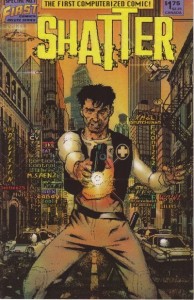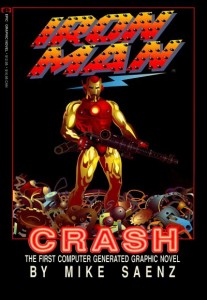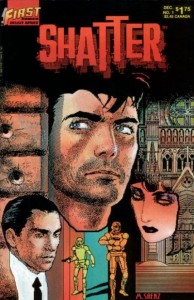 Question for the Professor:
Question for the Professor:
Hello, Phil!
When I was a lad, back in the ’80s, I had the opportunity to buy a special edition of Iron Man. It was a futuristic comic book and the drawings were made entirely in computer graphic software.
Unfortunately I DIDN’T BUY it (how stupid I am) and now I can’t find it anymore! I looked all over the internet….
I would be very glad if you could help me!
Thanks,
Ed from Brazil
Impressively, I actually knew this one (although I had to do some Googling — and some reading in the Overstreet Price Guide, and online at the Grand Comics Database — to flesh out the details, so maybe it’s not that impressive). The book Ed’s thinking of is a Marvel (well, Epic) graphic novel from 1988, called Iron Man: Crash; it was created by Mike Saenz, and billed as “the first computer generated graphic novel.” It’s set about 30 years in the future, where Tony Stark is still around, long retired from heroing but keeping himself artificially young, and caught up in some industrial-espionage/spy/technowar thing. You can tell that Seanz had been reading a lot of cyberpunk stuff, and the influence of Batman: The Dark Knight Returns (which had been published just two years before) is obvious — there’s even one of those patented Miller TV panel-grid info-dump sequences. The art is… primitive, in the same way that early CGI in movies was: pretty good on the special effects, but stiff and unconvincing with the humans, especially the faces. Still, considering that this came out a year before Tim Berners-Lee put the World Wide Web together for the first time, it’s an interesting achievement; if you were 15 years old when it came out, and into computers and comics, you’d have loved it, especially the seven pages in the appendix about how the book was created.
novel from 1988, called Iron Man: Crash; it was created by Mike Saenz, and billed as “the first computer generated graphic novel.” It’s set about 30 years in the future, where Tony Stark is still around, long retired from heroing but keeping himself artificially young, and caught up in some industrial-espionage/spy/technowar thing. You can tell that Seanz had been reading a lot of cyberpunk stuff, and the influence of Batman: The Dark Knight Returns (which had been published just two years before) is obvious — there’s even one of those patented Miller TV panel-grid info-dump sequences. The art is… primitive, in the same way that early CGI in movies was: pretty good on the special effects, but stiff and unconvincing with the humans, especially the faces. Still, considering that this came out a year before Tim Berners-Lee put the World Wide Web together for the first time, it’s an interesting achievement; if you were 15 years old when it came out, and into computers and comics, you’d have loved it, especially the seven pages in the appendix about how the book was created.
 By the way, although Crash is billed as the first computer graphic novel, it’s not the first computer-generated comic. That honor belongs to Saenz too, though: in 1985, he created Shatter, a regular four-color comic book, for First Comics; it was a similar future-type Blade Runneresque story that had a one-shot debut, and then a 14-issue regular-series run (although Saenz left after the first two issues), and is certainly the reason he was able to pitch the Iron Man book to Marvel. As an even earlier attempt, it’s even more primitive in its art, but again it’s remarkable that he created it at all; Shatter and Iron Man: Crash, with their exaggerated pixels and awkward expressions and occasionally-cool colors and designs, will always have a small but significant niche in comics history.
By the way, although Crash is billed as the first computer graphic novel, it’s not the first computer-generated comic. That honor belongs to Saenz too, though: in 1985, he created Shatter, a regular four-color comic book, for First Comics; it was a similar future-type Blade Runneresque story that had a one-shot debut, and then a 14-issue regular-series run (although Saenz left after the first two issues), and is certainly the reason he was able to pitch the Iron Man book to Marvel. As an even earlier attempt, it’s even more primitive in its art, but again it’s remarkable that he created it at all; Shatter and Iron Man: Crash, with their exaggerated pixels and awkward expressions and occasionally-cool colors and designs, will always have a small but significant niche in comics history.



